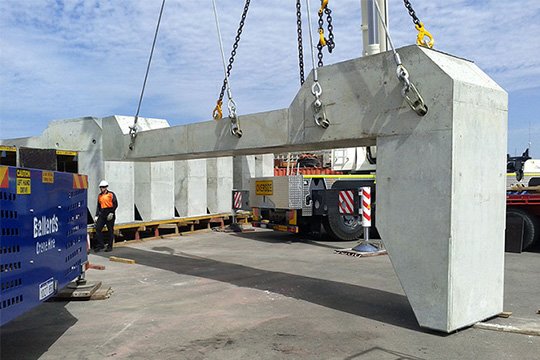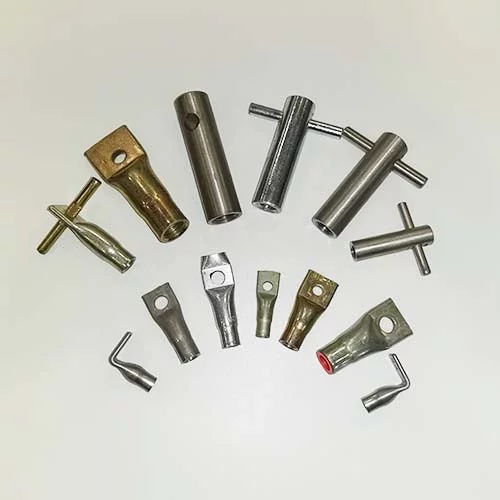How to Use Lifting Anchors for Precast Concrete

Precast Concrete (PC) is an important part of modern construction and infrastructure. It refers to concrete components that are prefabricated in factories. These components are widely used in construction due to their efficiency, precision, and sustainability. In the production, transportation, and installation of these components, the lifting anchor system plays an indispensable role.
Whether in the installation of precast panels in high-rise buildings, the lifting of large concrete modules in maritime engineering, or the transportation of heavy equipment in industrial manufacturing, the lifting anchor system has always demonstrated its powerful functions and adaptability. Through precise design, high-quality materials, and advanced production processes, these systems can meet the needs of different projects and ensure the efficiency and safety of each construction link.
Introduction
Lifting Anchor is a high-performance connector designed for lifting precast concrete components. It is made of high-quality round steel bars and uses a special forging process at the foot and head. The product is made of high-strength impact-resistant steel and processed by advanced hot forging technology, which can ensure safety and efficiency in the most demanding environments and construction conditions. HULK Metal's Lifting Anchor focuses on excellent design and craftsmanship, meets international quality standards, and provides reliable protection for your construction projects.
Lifting Anchor is available in a variety of lengths depending on the load requirements. The extended version of the boom is particularly suitable when the edge spacing needs to be reduced or when coping with lower concrete strength. For easy identification and traceability, each boom is engraved with detailed product identification, including the brand name "HULK Metal" or the customer's customized logo, as well as information such as boom length (mm) and load rating.

Main Benefits and Features
High safety and high efficiency: Designed to meet strict safety standards, it can quickly and safely complete the lifting of precast components.
Excellent wear resistance: The clutch has excellent wear and damage resistance, which can ensure stability after multiple uses.
Wide applicability: Suitable for various types of precast concrete components, including beams, walls, etc.
Multiple load levels: 8 different load levels are available, ranging from 1.3 tons to 32.0 tons, covering a wide range of construction needs.
Optimized length design: Flexible length options meet the needs of specific construction conditions, such as reducing-edge spacing or coping with low-strength concrete.
HULK Metal's Lifting Anchor adopts a comprehensive quality control system during the production process, including raw material testing, forging quality assessment, and finished product tensile testing to ensure that every product meets customer needs. Our products are not only a lifting tool, but also a guarantee of construction safety and efficiency.
Type
Spherical Head Lifting Anchors
Spherical Head Lifting Anchors are widely used lifting devices in precast concrete components. Its spherical head design provides excellent load-bearing capacity and operational convenience, especially for the lifting needs of heavy loads. This type of lifting anchor is used in conjunction with a dedicated lifting ring or hook to quickly achieve a safe connection. Due to its unique shape, the spherical head lifting anchor can evenly distribute the load and reduce concentrated stress, thereby improving the overall safety and stability of the component.
Double Head Anchors
Double Head Lifting Anchors are designed for the lifting and transportation of precast components. Its unique double-head structure provides greater stability and safety and is often used for longer or larger components, such as precast beams and columns. The double-head design not only improves the load-bearing capacity of the anchor but also effectively reduces the swing of the component during the lifting process, ensuring smooth and safe operation.
Lifting Eye Anchors
The lifting eye anchor is widely used in the lifting and transportation of various types of precast components due to its ring design. Its core feature is the eye ring design, which can be quickly connected to the hook or chain to improve operational efficiency. This type of anchor combines durability and safety, is suitable for the lifting of small to medium-sized components, and is an economical and efficient anchor solution.
Curved Pin Anchors
The curved pin anchor is suitable for precast components with special shapes or high requirements due to its unique structural design. The curved pin design enables it to adapt to complex lifting environments while providing excellent load-bearing capacity and operational flexibility. Its unique pin structure is tightly connected to the concrete component, and there will be no sliding or loosening problems during the lifting process. Due to its design advantages, the curved pin anchor has irreplaceable value in specific application scenarios.
Lifting Anchor Step-by-Step Guide
We have provided lifting anchors to customers in many regions around the world and provide users with detailed operation guides to ensure smooth progress and successful implementation of precast concrete projects. Here is a detailed step-by-step guide to its use:
Formwork preparation
Formwork preparation is the first and most important step in the use of precast concrete lifting anchors. The type and size of the formwork should be carefully designed according to the specific needs of the component.
Ensuring that the formwork is precisely constructed to perfectly fit the shape and size of the precast component, this refined design allows the lifting anchor to seamlessly integrate with the formwork, laying a solid foundation for the subsequent pouring and lifting phase.
Placing the lifting anchor
Once the formwork is prepared, the placement of the lifting anchor should be scientifically planned according to the weight distribution and lifting requirements of the precast component. The correct anchor point selection is essential to ensure overall stability and balance during the lifting process.
Embed the lifting anchor in the best position in the formwork to ensure that it can fully function during the pouring phase. This precise placement not only improves the structural integrity of the precast component but also ensures safe lifting operations later.
Concrete pouring
After the formwork preparation and anchor point placement are completed, we will move on to the next step, concrete pouring. During the pouring process, special attention should be paid to ensure that the anchors are fully embedded in the concrete and firmly bonded to the element after curing.
Correct anchor alignment and embedment depth are critical to the performance of the precast element. The anchors need to be fully encased in concrete to ensure that they can withstand the forces applied during subsequent lifting.
Curing and de-molding
After the concrete is poured, it needs to be cured according to the recommended process requirements to achieve the expected strength of the element and ensure its long-term durability and performance.
After curing, carefully remove the formwork to ensure that the anchors are secure and intact. Any loose or damaged anchors during the demoulding process will have an adverse effect on subsequent lifting operations.
Lifting operation
The lifting operation is the final stage of using the lifting anchor. By properly connecting the lifting equipment to the anchor points, the entire connection system is ensured to be stable and balanced.
The precast element is lifted step by step to reduce the risk of uneven pressure on both sides or anchors. A controlled and orderly approach can effectively reduce the risk of damage and ensure the overall success of the project.

Important points to keep in mind when using the Lifting Anchor
Follow the manufacturer's instructions
Strictly follow the manufacturer's product instructions, including specifications, load capacity, and operating instructions, to ensure safe use and optimal performance of the lifting anchor.
Perform load testing
HULK Metal has sampled and tested the lifting anchors before leaving the factory and will issue a tensile test report. You can also perform a load test before the official lifting to verify the load-bearing capacity of the lifting anchor. This step is an important part of the job plan to identify potential problems and improve system reliability.
Perform regular inspections
Perform a comprehensive inspection of the lifting anchor before each use to identify worn, corroded or damaged parts and replace them in time to maintain the structural integrity of the system.
Strengthen personnel training
Provide comprehensive training for operators to master the use of specific anchors, safety regulations, and emergency procedures to ensure safe operation on the construction site.
Consider weight distribution
When placing anchors, pay special attention to the weight distribution of components to ensure that the anchor points are evenly arranged to avoid tilting or shifting of components during lifting.
Use the right equipment
Choose lifting equipment that is compatible with the anchors, and ensure that the equipment is certified and regularly maintained to ensure stable and safe operations.
Develop an emergency plan
Design an emergency response plan for possible equipment failures or unexpected situations, and conduct regular drills to ensure that the team is always in the best response state.
With the above professional guidance, Especially using HULK Metal’s lifting anchor, your precast concrete project will achieve a more efficient and safer operation process to ensure project success.
Article Navigation
PRECAST CONCRETE ACCESSORIES
Other Precast Concrete Accessories You Might Want to Know
You can click to learn more about HULK Metal precast concrete accessories such as lifting anchors, precast sockets, spread anchors, shuttering magnets, cast-in channels, wire loop boxes, and other precast concrete accessories you might want to know.

























